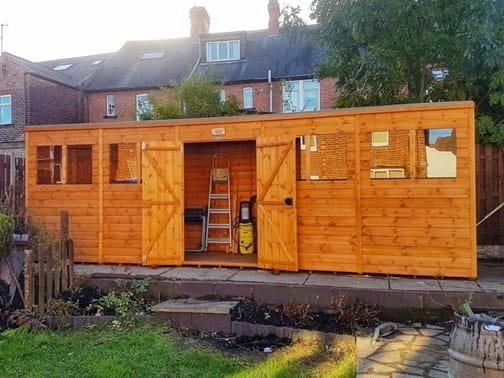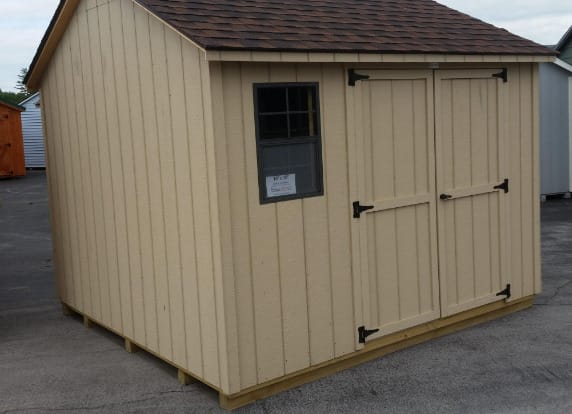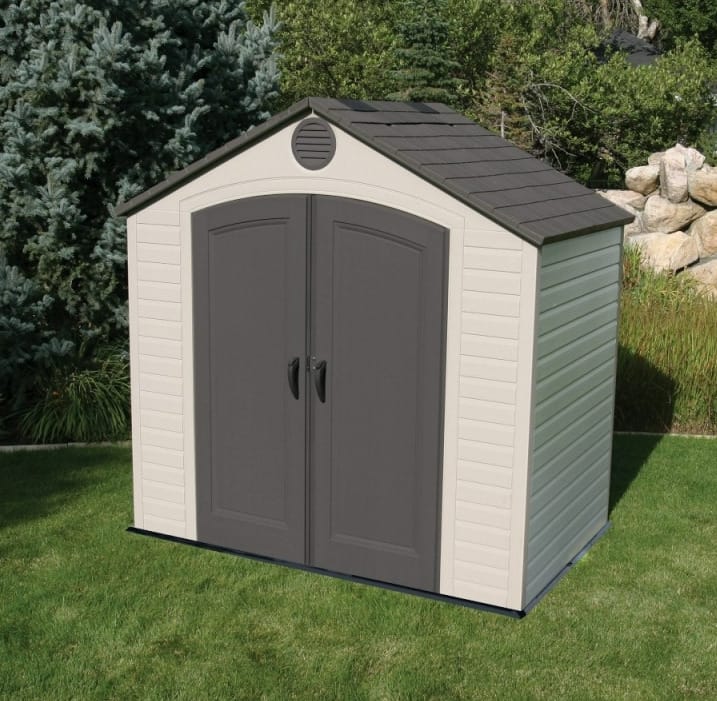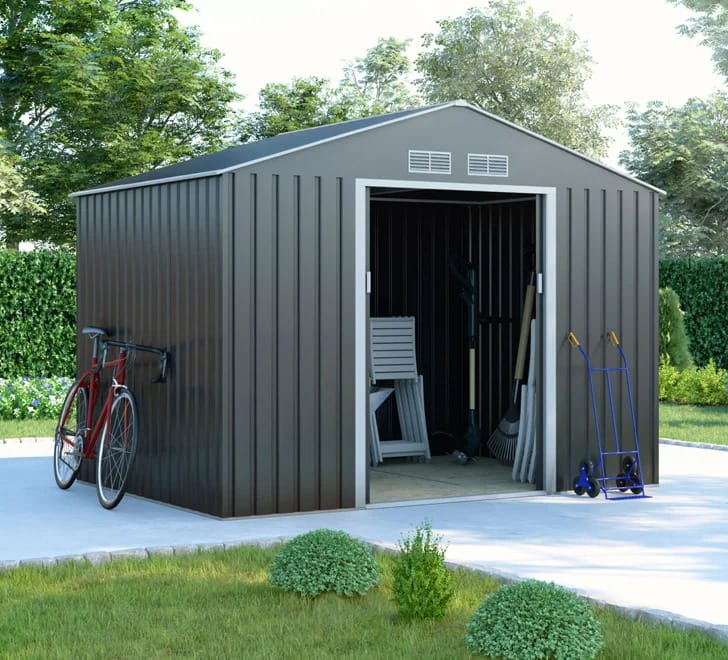Shed Buying Guide
Buying a shed involves a lot of different decisions that ultimately need to be made to help ensure you find the right style and size shed for your usage needs and the space you have available in your garden. With a variety of different options available, we wanted to make it easier to make the correct decision and help ensure you’re left with the perfect Power Shed.
In this shed buying guide, we’ll look at some of the biggest differences between sheds and the choices you’ll have to make when making a purchase.
How to Choose a Garden Shed
When considering how to choose a garden shed, there are plenty of options available. Plan how you wish for your shed to fit in with the general plan for your garden and how it’s going to interact with any other features such as plant beds, decking or patios. Buying a shed no longer means going to a garden centre, we have a wide range available online that can be fully viewed with a range of images and specification before you commit to buying one.
Choosing a Garden Shed: What to Consider
Buying a new shed is a big investment for your home and is something that should last for a substantial amount of time, this means that making the correct decision about which shed is right for you is a long-term and important financial choice. To help you make this decision there are a couple of basic things to consider:
Size
It perhaps goes without saying that one of the biggest factors when it comes to the size of your new shed is the amount of space you have available in your garden. Ensure you’ve got plenty of space to fit your new shed on its base, without getting too close to your neighbour’s property. If space isn’t an issue, think about what you’ll be using the shed for to determine the amount of space you’ll need and leaving enough room for annual preserver re-treatments.
Usage
If your garden shed is likely to be home to a lawnmower and a few garden tools, then something on the smaller end of the scale is advisable. However, many people are now using sheds for a multitude of different purposes, and this can affect the space you need. If you’re creating a workshop or a home office, you’re much more likely to need a bigger space in which to manoeuvre. All of our sheds are available in a range of different sizes, so you’ll never be stuck for choice.
Budget
As you’d expect, some retailers sell sheds at a much higher price point than others, however, this can often be reflected in the quality of the product. With that in mind, sometimes an unbelievable deal really is too good to be true. A shed is a long-term investment, keep this in mind when setting your budget. Certain factors, such as size, have a key influence on the price of a shed. Following the points above and buying a shed perfect for your requirements is a great way to ensure you don’t go over budget.
Roof Shape
There are two roof shapes to consider when you’re buying a shed – apex and pent. Although the shape of the roof might seem like a small matter when it comes to choosing the right shed, it can make a big difference. There’s much more information comparing the two below.
Material
These days sheds are made from a variety of different materials from the classic wood through to plastic and metal. This is another time to consider the long-term future of your shed and how it’s likely to be affected by the material it’s made from. Even different types of wood can make a difference, a cheaper shed may be made from cheaper, less durable wood and require repairs or replacing before long. Paying for more expensive materials may cost more initially but could end up saving you money in the long run.
Pent or Apex Shed: Is an Apex or Pent Shed Better?
Apex and pent are the two main options for a shed when it comes to the roof. Apex has two sloped sides to the roof which reach a peak in the middle, whereas a pent roof has one single slope, with the highest point of the slope being on either the front or back of the shed.
But is an apex or pent shed better? Once again, this all comes down to personal preference and, most importantly, what you intend to use the shed for. For those looking to use their shed simply as a storage space, a pent shed could be the ideal choice. For instance, it’s the perfect place to store garden tools, lawnmowers and things like bikes.
If you plan to use your shed as a more practical space, like a home office, an apex shedmight be a better option. The reason for this is that the roof provides much more headroom if you’re likely to be walking around, saving you a few sore bumps on the head.
Do I Need Windows in My Shed?
At Power Sheds, all of our sheds are adaptable, so you can choose how many windows you’d like – or whether you’d like any at all. The decision as to whether you’d like windows in your shed comes down to a number of factors, all of which are, you guessed it, linked to the intended use of the shed.
Firstly, you may feel like natural light would benefit your shed, for instance, if you’re using it as a practical space like a workshop or office. In this case, more windows might give the shed a feeling of being a bigger and more open space that’s connected to the outside. Also, if you’re using your shed to start off some of your shrubs and protect them from the elements, then having natural light can be extremely beneficial. Although in this situation, you may find an actual potting shed to be an even better choice.
If your shed is more likely to be used simply for storage, you may prefer to choose one without windows. This means that any potential thieves won’t be able to see what’s kept inside. If you’re really looking to keep something safe and secure, a security shed could also be a good idea.
How Many Doors Would Be Best?
Much like the windows, our products are adaptable to your needs when it comes to the doors. Sheds are available with either one door or double doors, giving you the option to make your shed as adaptable as possible. So, if you’re likely to be moving large items in and out and need that extra space you can choose a shed with double doors that make access easy.
Shed Size Guide
The size of the shed that you need can be affected by a number of different factors. The most important thing to consider is obviously the space available in your garden, make sure you consider the position of the shed with regards to your neighbour’s property. You can find out more information about planning permission here.
What’s the Most Economical Shed Size?
Being economical about your shed size means that you can ensure it’s not taking up too much space in your garden but get the most from the space you have. There’s no right or wrong answer when it comes to the size of shed you should choose, but it’s worth considering some of the following factors:
- How much space do you need inside the shed to fulfil its purpose?
- How much space do you have in the garden?
- What space will remain in the garden once the shed is installed?
- How will the shed affect light in the garden – for instance, will its position block out sunlight to plants, the lawn or seating areas?
Standard Shed Sizes
The most common and popular shed size is 8×6 feet, however, this doesn’t necessarily mean that it’s the right shed size for your needs. Having a range of options when it comes to size is very useful when you’re buying a shed, as the more variations of size you have available, the more likely it is that you’ll find the perfect fit for your garden space.
At Power Sheds, our sheds range from 4×4 right through to 20×8 feet and are fully customisable with the roof, window and door options that you require. This means that you’ll be able to find something that works for you and your specific requirements.
What Size Shed Do I Need?
If you want to find a perfect size shed for your garden and storage requirements, there are a few key things you should consider.
- How you’ll use the shed
A shed can be used for far more than just storage, and what you’re planning to use your shed for has a real influence on the size you need. If you are using it for storage, what are you planning on keeping in there? If you plan on using your shed as a workshop or a home gym, you need to consider spacing for shelving, benches and enough room for you to move around comfortably. Take this into consideration before you buy your new shed.
- Allow room for growth
The purpose of your shed can change, and it isn’t a bad idea to size up a bit for the future. You might decide you want to turn it from a storage solution to an office or bar. What you need to store in there could also change. If you have young kids for example, you might want to leave some room for bulkier toys, sports equipment or anything else.
- The size of your garden
If you’re only considering its usage, a shed can never be too big, but you need to make sure it fits in your garden and doesn’t ruin your current layout. A 12×8 or 14×8 shed is suitable for a larger garden, while a 10×6 or 8×6 shed is better for medium to small sized gardens. When looking a shed size, you need to be mindful of more than just the building itself. The foundation should be at the very least the size of the flooring of your building, and you need to look at the landscaping of your garden; will trees or other features get in the way?
You can browse all the shed sizes we have available at Power Sheds here.
Shed Materials and Treatments
As mentioned above, sheds are available in a wide variety of materials from wood to plastic or metal. Naturally, we’d always suggest choosing a wooden shed for your garden as the natural look of wood should fit much better within the space and it can be maintained much easier. Quality is the most important factor when it comes to choosing a wooden shed, as many low-cost models can be made from cheap wood that doesn’t stand up well to the elements.
Treatments: Pressure vs. Dipped
Dip treatment is a method of applying preservatives to timber. During this process, shed panels are dipped into a tank of preservative, fully submerging the panel into the treatment. All surfaces are thoroughly immersed before being removed and dried. It’s a fast, efficient, and economical way to treat panels.
Pressure treatment is similar to dip treatment, in that the wood is submerged in preservative, however, this type of treatment it’s done at high pressure. Preserving the wood at high pressure means that the preservative can penetrate the wood much deeper before it’s dried.
How Big a Shed Can I Build in My Garden?
How big a shed you can build in your garden really comes down to planning permission. There are set rules for people looking to build their own shed:
1* planning regulations for sheds state that:
- Sheds should be single-storey.
- Sheds should be a maximum of three metres high unless they have dual pitched roofs, in which case they can be up to four metres high.
- It has no verandas, balconies or any kind of raised platform as part of its basic construction.
- It has an occupied volume of no more than 15m squared.
- If you build a shed within two metres of your property boundary it can only be up to 2.5 metres high.
- Combined with other extensions and outbuildings, your shed should not cover more than 50 percent of the land around your original house.
- Sheds should not be built forward of any walls at the front of your house.
- It is not impinging on conservation areas or spaces of outstanding natural beauty or any other government-protected designated land (such as a world heritage site).
It’s also polite to consider your neighbours. Large sheds can be an eyesore and it’s worth asking if they’re ok with it before you get started; if not it could lead to a council investigation.
Shed Roofing Options
Whether you’re looking to buy a shed or renovating an existing one, the roof is one of the most important features and it’s important you know all your options when it comes to materials. There are three different types of shed roof you can choose from, which include pitched roofing materials, roofing sheets, and flat roofing materials. In this section, we look at each one in more detail.
Tiles and Shingles
These are some of the most common shed roof coverings because of their durability and refined appearance. You can use tiles and shingles to transform your shed into a smaller structure that better fits your garden and home.
Clay Roof Tiles
Clay roof tiles are a good choice for larger sheds made from sturdy materials. They’re great if you value appearance and complement any home or garden. Although they are at the higher end of the price bracket, you’ll get your return on investment in both look and quality.
Felt Shingles
Another popular option for a shed roof, felt shingles are available in a range of colours and finishes. They’re a great option if you’re working on a budget because of their low cost and are very easy to install. Despite the low cost, you can count on them to provide about 20 years of low maintenance protection.
Wood Shingles
Wood shingles can be made from cedar, oak and redwood, offering diversity when it comes to appearance. They’re a great balance between good performance and natural aesthetics and don’t have to be expensive. The cost depends on the wood you choose, with oak offering a more premium option. Wood shingles can last up to 40 years if installed properly.
Roofing Sheets
Roofing sheets are highly regarded for their protection, aesthetics and how easy they are to install. These materials are a great choice if you have a larger shed or garden building that needs covering.
Bitumen
Bitumen roofing sheets can be used for a wide range of garden buildings. They’re very cost-effective, durable, and easy to install, and are available in a selection of colours and finishes. They usually come with a standard corrugated profile and make a great option for your shed that can last up to 20 years.
Metal
Steel is one of the most durable and weather-resistant materials used for shed roofs. These coverings are very popular and are available as box profile and corrugated sheets. Despite its strength and modern appearance, metal roofing is reasonably priced and only requires a few basic tools to install.
Polycarbonate
Polycarbonate roofing is a new option that’s becoming very popular because it lets a lot of natural light into your shed and is cost-effective and lightweight. Installation is easy and polycarbonate gives you plenty of different styles and finishes so you can find the perfect new look for your shed.
Flat Roofing Materials
Flat roofs are easy to install and built to be durable and long-lasting. If you want a flat roof you need to choose a high-quality material that will mitigate the risk of leaks and other issues.
EPDM Rubber Roofing
EPDM rubber is a less traditional roofing option for sheds but has a range of benefits that make it perfect for non-pitched structures. It is cost-effective, easy to install and can have a lifespan of up to 50 years. EPDM rubber is also incredibly durable, and waterproof; the only downside is it’s not as aesthetically pleasing as other material options.
Shed Felt
This classic roof covering is arguably the most cost-effective options out there, and you can choose from a range of styles and colours to find the perfect look for your shed. Lifespan can vary between 10 and 30 years depending on installation and weather.
What is the Best Material for A Shed Roof?
Choosing the best material for your shed roof comes down to personal requirements and what you need from your new roof. If you’re looking to be cost-effective, bitumen roofing sheets are a great option. If durability is your priority, then opting for metal roofing sheets is recommended. For sheds with a flat roof, EPDM rubber blends simple installation with impressive longevity. Finally, if visual appearance is at the top of your shopping list, clay roof tiles look great on any shed design.
Will I Need a Base for my Shed?
Every shed needs a base, so the simple answer is yes. It’s important that your shed sits on a base for a couple of reasons. Firstly, to keep your shed from sinking into the ground through subsidence, it’s important that it sits on a solid base. Secondly, if your wooden shed was to be placed on the ground, the wood will be exposed to any moisture and can deteriorate over time.
There are several solutions to this, you can opt for a wooden base kit, or use concrete or flagstones for your base. The most important thing to remember is that your shed base should be completely level.
You can find out more about building a shed base in our How to Build a Shed Base guide.
How Long Do Sheds Last?
How long a shed lasts depends on a few different factors. Material, maintenance, and the weather all have a lasting effect on your shed and can influence its lifespan.
Life Expectancy: Vinyl, Wood, Plastic and Metal Sheds
Vinyl Sheds – 25+ Years
Vinyl sheds are some of the most durable available and don’t require a lot of maintenance. They also won’t need to be repainted or resealed, but they are one of the most expensive options out there.
Wooden Smart Panel Sheds – 20-25 Years
Wooden sheds are a traditional option and smart panels offer a rustic look, great price and longer lifespan. With careful maintenance, you can expect a wooden smart panel shed to last over 20 years.
Plastic or Resin Sheds – 5-7 Years
Plastic sheds are more vulnerable to the elements that wood or vinyl. It won’t rust or rot, but plastic expands and contracts in the sun which leads to cracking and leaks. They are a cheaper option, but it’s better to invest in wood or vinyl if lifespan is a priority.
Metal Sheds – Less than 5 Years
Metal sheds’ lifespan really depends on the quality of metal. Cheap metal is very susceptible to rust and after a few years of rain will start to become damaged and leak. Higher-quality metal provides reliable, watertight storage and will last longer.








